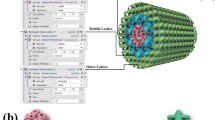Abstract
This study presents a process of establishing a multiaxial Weibull model to assess S45C steel reliability and high-cycle fatigue. The proposed model includes multiaxial stress state, stress gradient and component size factors, and the probability of failure. The model was based on multiaxial fatigue theory, where the expressed damage parameter is a single value for one cycle of the multiaxial stress state, combined with the weakest link concept. Through the maximum likelihood method (MLE), a probabilistic stress-life (P-S-N) curve that reflects both failure and right-censored data was plotted; whereas optimal Weibull parameters were estimated via the differential ant-stigmergy algorithm (DASA). The completed multiaxial Weibull model was then applied to S45C steel tension-compression (TC) and zero-tension (ZT) fatigue test data, both of which agreed well. Afterward, the model was cross-checked with torsion fatigue test data results for validity.
Similar content being viewed by others
References
I. V. Papadopoulos, Long life fatigue under multiaxial loading, International Journal of Fatigue, 23 (10) (2001) 839–849.
H. Hamidian, A. T. Lahijani and S. Shahriari, Fatigue life enhancement of automobile wheel disc considering multi-axial stresses based on critical plane approach, Journal of Mechanical Science and Technology, 31 (6) (2017) 2883–2892.
K. Dang Van, B. Griveau and O. Message, On a new multi-axial fatigue limit criterion: theory and application. Biaxial and Multiaxial Fatigue EGF3, M. W. Brown and K. J. Miller (Eds.), International Conference on Biaxial/Multiaxial Fatigue, London, England, UK (1989) 479–496.
K. Dang Van, Macro-micro approach in high-cycle multiaxial fatigue, advances in multiaxial fatigue, D. L. McDowell and R. Howell (Eds.), Proc. of Advances in Multiaxial Fatigue, ASTM STP 1191, West Conshohocken, PA, USA (1993) 120–130.
P. Ballard, K. Dang Van, Y. Deperrois and V. Papadopoulus, High-cycle fatigue and a finite element analysis, Fatigue & Fracture of Engineering Materials & Structures, 18 (3) (1995) 397–411.
L. Flaceliere and F. Morel, Probabilistic approach in high-cycle multiaxial fatigue: Volume and surface effects, Fatigue & Fracture of Engineering Materials & Structures, 27 (12) (2004) 1123–1135.
W. Weibull, A Statistical Theory of the Strength of Materials, Royal Swedish Institute for Engineering Research 151, Stockholm (1939).
H. Bomas, T. Linkewitz and P. Mayr, Application of a weakest-link concept to the fatigue limit of the bearing steel SAE 52100 in a bainitic condition, Fatigue & Fracture of Engineering Materials & Structures, 22 (9) (1999) 733–741.
H. Bomas, P. Mayr and T. Linkewitz, Inclusion size distribution and endurance limit of a hard steel, Extremes, 2 (2) (1999) 149–164.
T. Delahay and T. Palin-Luc, Estimation of the fatigue strength distribution in high-cycle multiaxial fatigue taking into account the stress-strain gradient effect, International Journal of Fatigue, 28 (2006) 474–484.
A. Wormsen, B. Sjödin, G. Hárkegård and A. Fjeldstad, Non-local stress approach for fatigue assessment based on weakest-link theory and statistics of extremes, Fatigue & Fracture of Engineering Materials & Structures, 30 (12) (2007) 1214–1227.
A. Karolczuk and T. Palin-Luc, Modelling of stress gradient effect on fatigue life using Weibull based distribution function, Journal of Theoretical and Applied Mechanics, 51 (2) (2013) 297–311.
J. Correia, N. Apetre, A. Arcari, A. De Jesus, M. Muniz-Calvente, R. Calçada, F. Berto and A. Fernández-Canteli, Generalized probabilistic model allowing for various fatigue damage variables, International Journal of Fatigue, 100 (Part 1) (2017) 187–194.
N. Apetre, A. Arcari, N. Dowling, N. Iyyer and N. Phan, Probabilistic model of mean stress effects in strain-life fatigue, Procedia Engineering, 114 (2015) 538–545.
M. Kamal and M. M. Rahman, Advances in fatigue life modeling: A review, Renewable and Sustainable Energy Reviews, 82 (2018) 940–949.
J. Klemenc and M. Fajdiga, Estimating S-N curves and their scatter using a differential ant-stigmergy algorithm, International Journal of Fatigue, 43 (2012) 90–97.
National Research Institute for Metals, Fatigue Data Sheet, http://web.archive.org/web/20180909101737/http://smds.ni ms.go.jp/fatigue/index_en.html, Accessed 9 Sep. (2018).
L. Blacha and A. Karolczuk, Validation of the weakest link approach and the proposed Weibull based probability distribution of failure for fatigue design of steel welded joints, Engineering Failure Analysis, 67 (2016) 46–62.
M. Dejack, C. C. Engler-Pinto Jr., J. V. Lasecki, R. J. Frisch and J. E. Allison, Statistical approaches applied to fatigue test data analysis, SAE Technical Paper Series 2005-01-0802, Warrendale PA, USA (2005).
F. G. Pascual and W. Q. Meeker, Estimating fatigue curves with the random fatigue-limit model, Technometrics, 41 (4) (1999) 277–289.
J. Klemenc, Influence of fatigue-life data modelling on the estimated reliability of a structure subjected to a constant-amplitude loading, Reliability Engineering & System Safety, 142 (2015) 238–247.
M. Dorigo, V. Maniezzo and A. Colorni, Ant system: Optimization by a colony of cooperating agents, IEEE Transactions on Systems, Man, and Cybernetics, Part B, 26 (1) (1996) 29–41.
S. Goss, S. Aron, J. L. Deneubourg and J. M. Pasteels, Self-organized shortcuts in the Argentine ant, Naturwissenschaften, 76 (1989) 579–581.
P. Korošec, J. Šilc and B. Filipič, The differential antstigmergy algorithm, Information Sciences—Informatics and Computer Science, Intelligent Systems, Applications: An International Journal, 192 (2012) 82–97.
Author information
Authors and Affiliations
Corresponding author
Additional information
Recommended by Associate Editor Nam-Su Huh
Yonghun Yu is a Ph.D. student of Mechanical Engineering, Pusan National University, Busan, Korea. He received his B.S. degree in Mechanical Engineering from Pusan National University. His research interest includes tribology.
Bora Lee is a Ph.D. student of Mechanical Engineering, Pusan National University, Busan, Korea. She received her B.S. degree in Nanomechatronics Engineering from Pusan National University. Her research interest includes tribology.
Yongjoo Cho is a Professor at the School of Mechanical Engineering, Pusan National University, Busan, Korea. He received his Ph.D. degree in Mechanical Engineering from Korea Advanced Institute of Science and Technology (KAIST), Korea in 1994. His research fields include tribology, contact mechanics, contact fatigue, surface topology, lubrication and wear for mechanical device.
Rights and permissions
About this article
Cite this article
Yu, Y., Lee, B. & Cho, Y. Multiaxial fatigue reliability assessment using a differential ant-stigmergy algorithm. J Mech Sci Technol 33, 2093–2099 (2019). https://doi.org/10.1007/s12206-019-0413-z
Received:
Revised:
Accepted:
Published:
Issue Date:
DOI: https://doi.org/10.1007/s12206-019-0413-z




